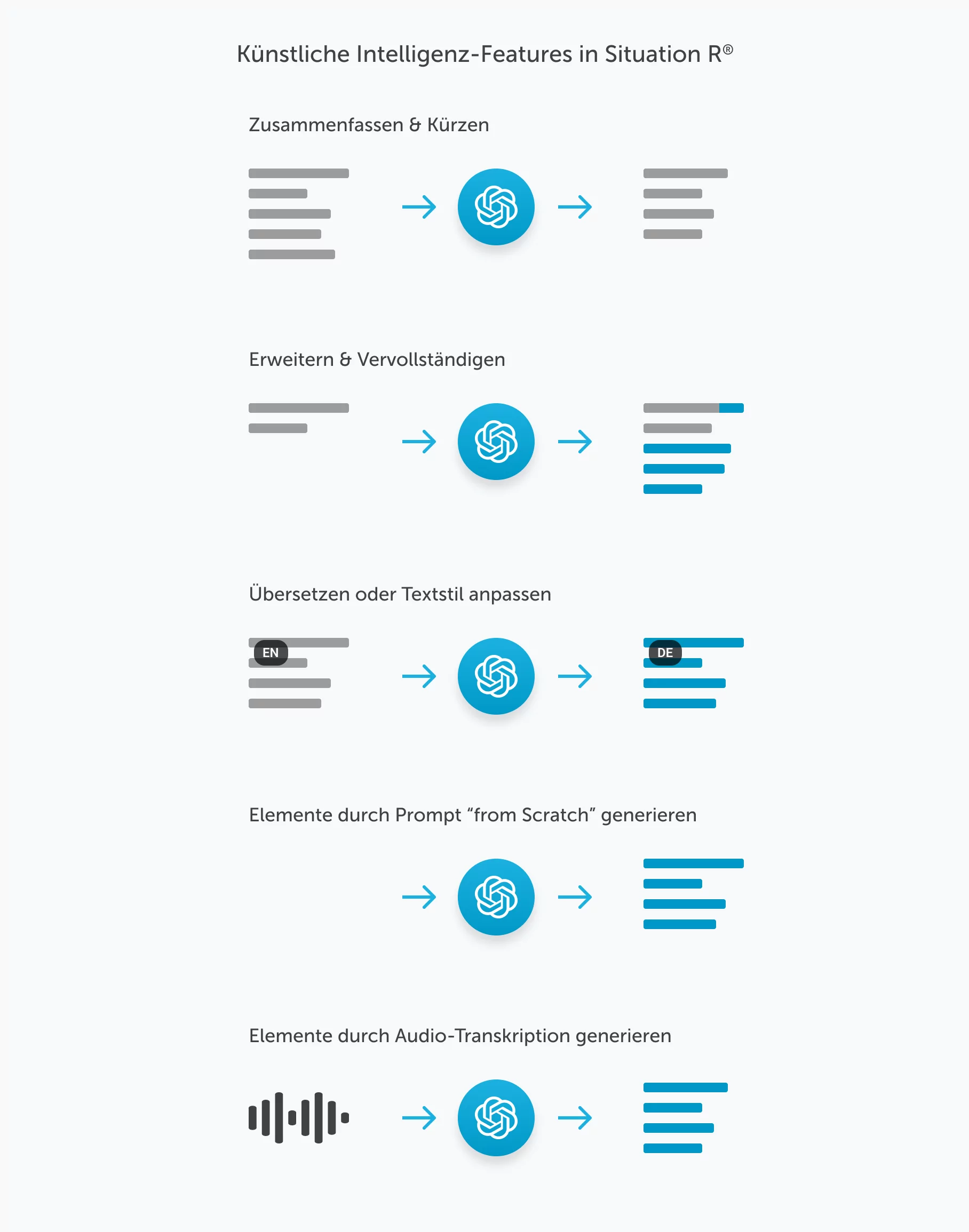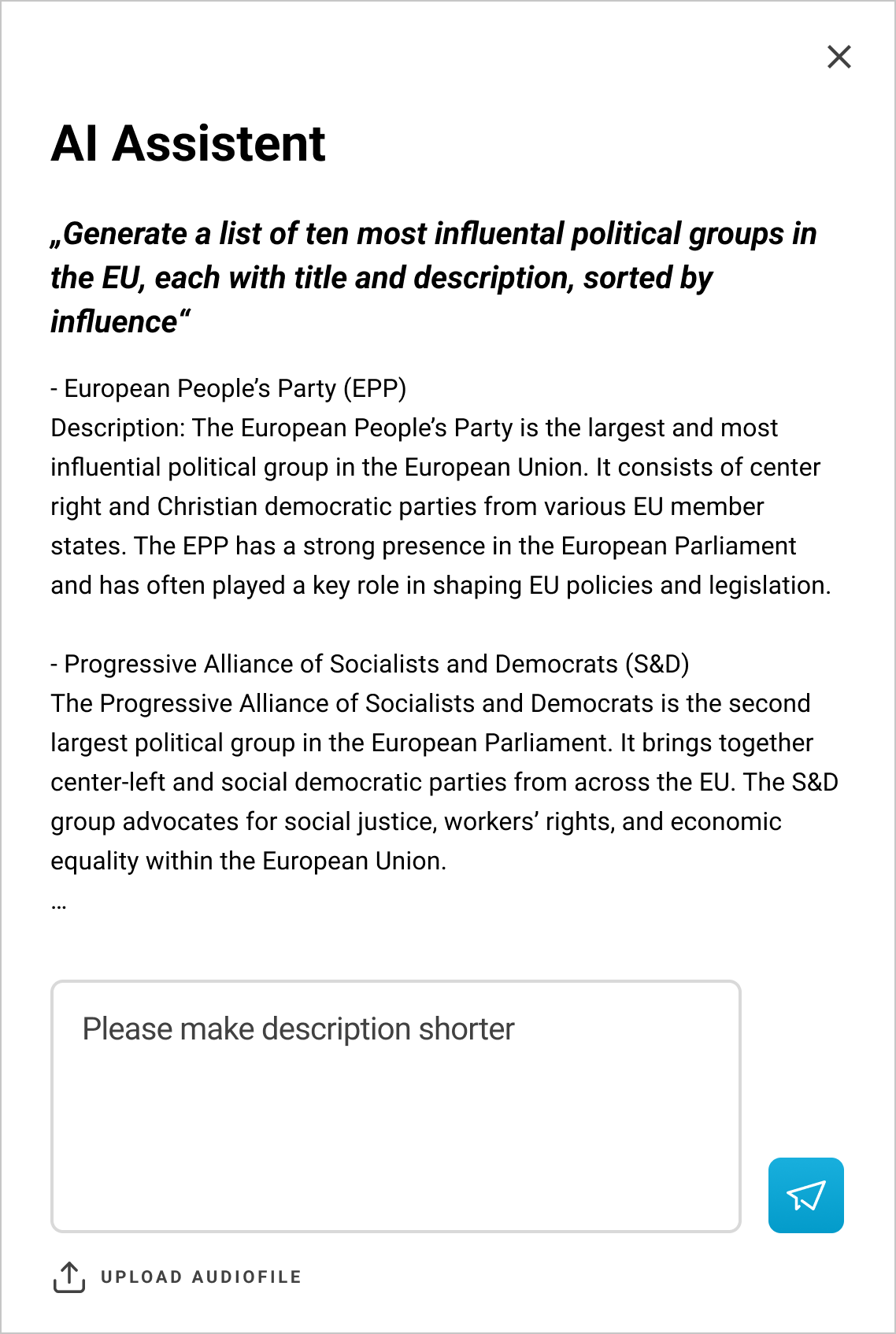Using artificial intelligence to improve the user experience of a software product.
How artificial intelligence simplifies the lives of users by integrating it into our client’s existing software product. A case study away from classic AI use cases.
by Philipp Brunner
28.08.2023

Artificial intelligence has been on everyone’s lips for some time now. Countless blog posts, newspaper articles and tweets warn us of the end of the familiar working world, or remind us which AI skills we absolutely need to catch up with the competition or to increase our productivity immeasurably.
Really striking how every AI hype tweet is explicitly trying to induce FOMO. “You’re getting left behind. All your competitors are using this. Everyone else is making more money than you. Everyone else is more productive. If you’re not using the latest XYZ you’re missing out.”
— François Chollet (@fchollet) April 14, 2023
Compositions created by image-generating artificial intelligences such as Midjourney, Dall-e2 or Firefly are impressive and – especially for us designers – frighteningly good.
There is no doubt that current developments in the field of artificial intelligence are groundbreaking and will change our world forever. At dmcgroup, we do not see these developments as a threat to our existing fields of activity, but rather as enriching new opportunities for the creative process.
Large Language Models – What’s behind the “artificial intelligence” hype?
It’s not easy to describe what artificial intelligence is all about. A more precise definition of “intelligence” is beyond the scope of this article. A more precise definition of “intelligence” would go beyond the scope of this article. Other authors have also racked their brains over it and were able to come to terms with this definition.
“Artificial intelligence: an entity that performs behaviors that could reasonably be described as intelligent if a human were to do something similar.”
Aus “A Very Gentle Introduction to Large Language Models without the Hype” von Mark Riedl
Or to put it another way: automated activities that require a certain amount of interpretation, combinatorics and non-trivial execution can be described as artificial intelligence.
Artificial intelligence in computer games is often cited as an example of this: Game characters that are not played by humans, but react to their actions in the game. Put simply, this is achieved by numerous If-Then queries (“if the player is within range then shoot else move to the nearest boulder for cover”), but these are sufficient to give us the impression of a “living” entity that interacts with us.
Artificial intelligence can never work without huge amounts of data in the background. In the “Large Language Model”, these data volumes meet algorithms as a “knowledge base” that can evaluate patterns in them. The database of the Large Language Model is basically similar to the index of a search engine such as Google, which has been familiar for years: An unimaginably large amount of information that is compiled by systematically scouring the Internet: useful, factually correct, but also often useless and erroneous.
The ability to interpret natural language input and provide seemingly appropriate answers via pattern recognition has improved considerably. Whether an answer is assessed as correct is basically the result of an evaluation of probabilities that have been enriched in the training of the model.
Use cases for artificial intelligence in the creative industry
How can artificial intelligence support us? What are the areas of application of artificial intelligence in the day-to-day work of a creative agency? The strengths of artificial intelligence lie in these areas:
- Pattern identification
- Image recognition
- Natural language processing
- Automated data processing
- Learning ability
- Specification and processing of unstructured data
In our day-to-day work as a digital agency, there are numerous activities in which we now benefit greatly from the use of artificial intelligence:
- Automated content creation – text, graphics, images & video
We use artificial intelligence to create text, graphics, images and videos. Especially in brainstorming and mood phases, AI opens up new possibilities to quickly achieve initial results and generate output. This in no way replaces “traditional” content production, but rather uses artificial intelligence to expand and accelerate the process. - Automation of standard tasks in image processing and motion design:
a radical reduction in working time for tasks such as image enhancement, image retouching, color adjustments or similar. - Artificial voiceovers and soundtracks:
In the field of motion design, we often use artificial intelligence to quickly create voiceover commentaries or background music for moving image contributions - Research work, problem-solving support:
Despite all the caution that must be exercised when using artificial intelligence as a “knowledge provider”, it helps us to expand our knowledge quickly, efficiently and in a targeted manner. For example, our front-end unit uses AI to obtain starting points for problem solving when coding and to quickly delve into new subject areas. - Structuring and optimization or translation of text data:
With the help of artificial intelligence, stylistic text tasks that used to take a long time can now be completed with just a few text prompts: Shortening texts, adapting styles, structuring bulleted lists or translating into other languages. These tasks do not always deliver the right result immediately, but the increase in efficiency with the help of artificial intelligence is considerable.
This list includes tasks that we use AI solutions to help us complete. Artificial intelligence is therefore not directly visible to our customers.
But what about the direct integration of AI solutions into digital products for our customers? There is also a lot of potential here, as an exciting case for one of our customers shows…
Artificial intelligence has been on everyone’s lips for some time now. Countless blog posts, newspaper articles and tweets warn us of the end of the familiar working world, or remind us which AI skills we absolutely need to catch up with the competition or to increase our productivity immeasurably.
Really striking how every AI hype tweet is explicitly trying to induce FOMO. “You’re getting left behind. All your competitors are using this. Everyone else is making more money than you. Everyone else is more productive. If you’re not using the latest XYZ you’re missing out.”
— François Chollet (@fchollet) April 14, 2023
Learn
more
We’re more than just AI experts – our dedicated team of designers, developers and marketing specialists work hand in hand to take your digital presence to the next level.
Ready for the next step in artificial intelligence?
Contact us and find out more about our services.
Use case Situation R®: A software for the implementation of decision making workshops
Our client FAS Research is a leading company in the network-based creation of situation reports and strategies. In a joint team led by FAS Research, we have been developing the software for one of their consulting products for several years.
In the context of interactive group processes, FAS Research enables teams to make large, strategic decisions in short periods of time. This takes place in collaborative workshop formats (both on-site and remote), in which participants vote live on issues jointly developed in the workshop and thus arrive at a consolidated picture of the situation on complex topics – all within a few hours.
The software, which we are developing together with our client FAS Research, supports both their moderators in preparing and moderating a workshop and participants in voting with the help of their smartphones.

Reduction of “cognitive load” for moderators through artificial intelligence
The work of FAS research moderators is challenging: In the workshop, the topics on which a vote is to be held are usually developed “live” with the participants. Meanwhile, facilitators must moderate the process and at the same time record and consolidate the collected proposals and build consensus in the group. You can imagine that this is a cognitively challenging multitasking activity.
The moderators are crucial to the success of the FAS Research workshops – through their ability to actively support groups in the decision-making process.
The activities involved in writing down the collected inputs are tasks that can be excellently supported by artificial intelligence:
- marize/shorten a list of text element
- Extend/complete a list of text elements
- Adapt the text style (e.g. more formal, more colloquial …)
- Translate a text into another language
FAS Research had been developing plans to integrate artificial intelligence into the workshop software for some time and found a reliable and creative partner for the implementation in dmcgroup.
Our joint solution in the moderation software relies on the integration of the text AI ChatGPT. Together with a prompt (a type of command that gives the artificial intelligence instructions for processing the transferred texts), existing texts are transferred and displayed again in the desired processing in a short time.
At all times, moderators have full control over which text suggestions are accepted or rejected.
Nevertheless, by using artificial intelligence to complete time-consuming routine tasks, moderators can save valuable time and concentrate fully on moderating the workshop and working with the workshop participants.

Ask artificial intelligence – or let it listen in
Text is not always developed together in the workshop as mentioned above. Sometimes (generic) content is prepared in advance by moderators only.
In this case too, AI integration increases the efficiency of the work: just by specifying a prompt,a list of elements can be created directly “from scratch”. In addition to the stylistic work, research work can also be outsourced.
The latest feature enhancement to the software uses “Whisper”, an audio AI that translates audio recordings directly into text.
The future of the workshop is therefore: let the microphone run & the artificial intelligence automatically captures what is spoken in the workshop in text – of course only with the prior consent of all participants and in compliance with all data protection regulations.
Moderators can continue working directly with the automatically transcribed content through appropriate prompting – for example, to consolidate it into a compact list.

Iterative improvement – artificial intelligence as a “sparring partner” always in the loop
This further work with text inputs is at the heart of AI integration in the Situation R® software.
However AI support begins:
- Generation of texts “from scratch”
- Further work with existing texts
- Transcription of an audio recording
The use of artificial intelligence does not end here. In the course of the work, the context of the previous text manipulation always remains “in the memory” of the integrated AI. Each new prompt builds on the previous commands and content and thus enables the iterative improvement of the content.
The seamless integration of artificial intelligence into the software eliminates the need to switch to the browser or between tools. As in a conversation, moderators work step by step to create and optimize the text content.
Handle with care – disadvantages of artificial intelligence
Data protection and the sensitive handling of customer information are a top priority for FAS Research. Especially in the relatively young field of the application of artificial intelligence, this is an indispensable duty.
As with any technology, there are also “disadvantages” that need to be taken into account:
- Artificial intelligence is ultimately a black box
The underlying algorithms, knowledge base and decisions remain in the dark. The results of artificial intelligence can differ from one query to the next. Answers involve a certain degree of unreliability. - Data privacy
Every request to artificial intelligence such as ChatGPT is stored on third-party servers – and may even be used to train the AI. It therefore goes without saying that AIs should not be fed with confidential data. - Fake infos
The results provided by artificial intelligence are made up of Internet data that is selected as an answer on the basis of statistical models. Since this is only about probability calculation, true and false are not dimensions. AIs often provide factually incorrect answers.
Like any technology, the use of artificial intelligence also has potential disadvantages.
However, with the necessary sensitivity and control, their use offers exciting new possibilities for improving the user experience.
From the latest industry trends and the latest insights into AI and UX/UI design to exciting use cases.
Sign up for our monthly newsletter and stay up to date!
Stay
tuned
More articles